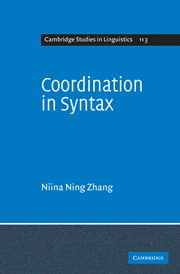Book contents
- Frontmatter
- Contents
- Acknowledgments
- Abbreviations
- 1 Introduction
- PART I NO SPECIAL SYNTACTIC CONFIGURATION
- PART II NO SPECIAL SYNTACTIC CATEGORY
- PART III NO SPECIAL SYNTACTIC CONSTRAINT
- 4 The Conjunct Constraint and the lexical properties of coordinators
- 5 The Element Constraint and the semantic relatedness of conjuncts
- 6 Three puzzles solved by rejecting the CSC
- 7 Relativized parallelism in syntactic complexes
- PART IV NO SPECIAL SYNTACTIC OPERATION
- 10 Conclusions
- References
- Index
7 - Relativized parallelism in syntactic complexes
from PART III - NO SPECIAL SYNTACTIC CONSTRAINT
Published online by Cambridge University Press: 04 August 2010
- Frontmatter
- Contents
- Acknowledgments
- Abbreviations
- 1 Introduction
- PART I NO SPECIAL SYNTACTIC CONFIGURATION
- PART II NO SPECIAL SYNTACTIC CATEGORY
- PART III NO SPECIAL SYNTACTIC CONSTRAINT
- 4 The Conjunct Constraint and the lexical properties of coordinators
- 5 The Element Constraint and the semantic relatedness of conjuncts
- 6 Three puzzles solved by rejecting the CSC
- 7 Relativized parallelism in syntactic complexes
- PART IV NO SPECIAL SYNTACTIC OPERATION
- 10 Conclusions
- References
- Index
Summary
Introduction
In Chapters 4 and 5, I linked the effects of the CSC to the lexical–syntactic properties of coordinators and the semantic relations between conjuncts. In this chapter I examine the CSC together with some other constraints which have also been claimed to apply exclusively in coordinate complexes.
Many authors consider Ross's CSC to be related to or covered by the Parallelism Requirement (PR). The PR is a label for the generally recognized requirement that the syntactic and semantic representations of the components in syntactic complexes must not only be well-formed independently, but also symmetrical or parallel to each other. In particular, it has long been realized that the conjuncts in a coordinate complex obey something like the PR. However, it is not clear what part of the cognitive system is responsible for the PR, nor how far coordinate complexes actually obey it.
Moreover, although many authors have attempted to account for the CSC in terms of some version of PR, or at least to link the two notions, the implementation of the PR itself remains a controversial issue. As a type of PR, the CSC has been analyzed as a trigger of movement (Hornstein and Nunes 2002), a constraint on movement (Williams 1978: 37; Pesetsky 1982; and Postal 1998), and as a constraint on merge (Johnson 2002a).
- Type
- Chapter
- Information
- Coordination in Syntax , pp. 177 - 204Publisher: Cambridge University PressPrint publication year: 2009



